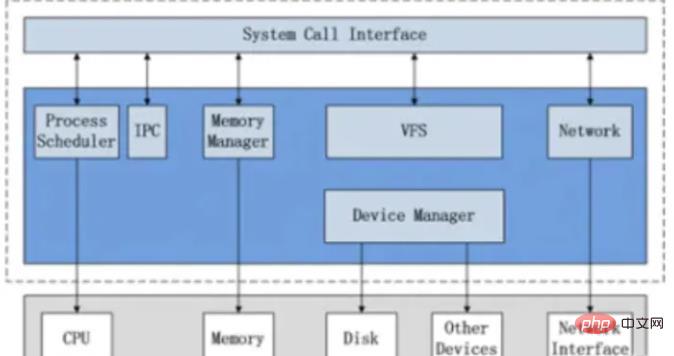 Operation and Maintenance
Operation and Maintenance
 Linux Operation and Maintenance
Linux Operation and Maintenance
 What parts does the function of the linux kernel consist of?
What parts does the function of the linux kernel consist of?
What parts does the function of the linux kernel consist of?
The function of the Linux kernel consists of 5 parts, namely process management, memory management, inter-process communication, virtual file system and network interface; Linux is an open source computer operating system kernel, which is written in C language Written as a Unix-like operating system that complies with POSIX standards.

#The operating environment of this tutorial: linux5.9.8 system, Dell G3 computer.
What parts does the function of the Linux kernel consist of?
A complete Linux kernel generally consists of 5 parts, which are process management, memory management, inter-process communication, virtual file system and network interface.

Linux is an open source computer operating system kernel. It is a Unix-like operating system written in C language and compliant with POSIX standards.
Linux was first developed by Linus Torvalds of Finland in an attempt to provide a free Unix-like operating system on the Intel x86 architecture. The project started in 1991, with some Minix hackers assisting in the early days of the project, and now countless programmers around the world are helping the project for free.
The operating system is a low-level support software used to deal with hardware and provide a limited set of services for user programs. A computer system is a symbiosis of hardware and software. They are interdependent and inseparable. Computer hardware includes peripherals, processors, memory, hard drives, and other electronic devices that make up the computer's engine. But without software to operate and control it, it cannot work by itself. The software that completes this control work is called the operating system. In Linux terminology, it is called the "kernel" or "core". The main modules (or components) of the Linux kernel are divided into the following parts: storage management, CPU and process management, file system, device management and driver, network communication, as well as system initialization (boot), system calls, etc.
The Linux kernel uses three different version numbering methods.
The first method is used before version 1.0 (including 1.0). The first version was 0.01, followed by 0.02, 0.03, 0.10, 0.11, 0.12, 0.95, 0.96, 0.97, 0.98, 0.99 and then 1.0.
The second method is used from 1.0 to 2.6. The number consists of three parts "A.B.C", A represents the major version number, B represents the minor version number, and C represents the smaller final version number. A only changes when the kernel changes significantly (it has only happened twice in history, 1.0 in 1994 and 2.0 in 1996). You can judge whether Linux is stable by the number B. The even-numbered B represents the stable version, and the odd-numbered B represents the development version. C represents the number of bug fixes, security updates, new features and drivers. Taking version 2.4.0 as an example, 2 represents the major version number, 4 represents the minor version number, and 0 represents the final version number with minor changes. In the version number, a version with an even number in the second digit of the serial number indicates that it is a stable version that can be used, such as 2.2.5, while a version with an odd number in the second digit of the serial number generally has some new things added, which is not necessarily the case. Very stable test version, such as 2.3.1. In this way, the stable version is derived from the upgrade version number of the previous beta version, and a stable version will no longer develop after it develops to full maturity.
The third method, starting from version 2.6.0 in 2004, uses a "time-based" method. Before version 3.0, it was an "A.B.C.D" format. In seven years, the first two numbers A and B, namely "2.6", have remained unchanged, C has increased with the release of new versions, and D represents the number of bug fixes, security updates, and the number of new features and drivers added. After version 3.0, there is the "A.B.C" format, B increases with the release of new versions, and C represents the number of bug fixes, security updates, new features and drivers. In the third method, the naming method such that even numbers represent stable versions and odd numbers represent development versions is no longer used. For example: 3.7.0 does not represent the development version, but the stable version.
Recommended learning: "Linux Video Tutorial"
The above is the detailed content of What parts does the function of the linux kernel consist of?. For more information, please follow other related articles on the PHP Chinese website!

Hot AI Tools

Undresser.AI Undress
AI-powered app for creating realistic nude photos

AI Clothes Remover
Online AI tool for removing clothes from photos.

Undress AI Tool
Undress images for free

Clothoff.io
AI clothes remover

Video Face Swap
Swap faces in any video effortlessly with our completely free AI face swap tool!

Hot Article

Hot Tools

Notepad++7.3.1
Easy-to-use and free code editor

SublimeText3 Chinese version
Chinese version, very easy to use

Zend Studio 13.0.1
Powerful PHP integrated development environment

Dreamweaver CS6
Visual web development tools

SublimeText3 Mac version
God-level code editing software (SublimeText3)

Hot Topics
 What computer configuration is required for vscode
Apr 15, 2025 pm 09:48 PM
What computer configuration is required for vscode
Apr 15, 2025 pm 09:48 PM
VS Code system requirements: Operating system: Windows 10 and above, macOS 10.12 and above, Linux distribution processor: minimum 1.6 GHz, recommended 2.0 GHz and above memory: minimum 512 MB, recommended 4 GB and above storage space: minimum 250 MB, recommended 1 GB and above other requirements: stable network connection, Xorg/Wayland (Linux)
 vscode cannot install extension
Apr 15, 2025 pm 07:18 PM
vscode cannot install extension
Apr 15, 2025 pm 07:18 PM
The reasons for the installation of VS Code extensions may be: network instability, insufficient permissions, system compatibility issues, VS Code version is too old, antivirus software or firewall interference. By checking network connections, permissions, log files, updating VS Code, disabling security software, and restarting VS Code or computers, you can gradually troubleshoot and resolve issues.
 How to run java code in notepad
Apr 16, 2025 pm 07:39 PM
How to run java code in notepad
Apr 16, 2025 pm 07:39 PM
Although Notepad cannot run Java code directly, it can be achieved by using other tools: using the command line compiler (javac) to generate a bytecode file (filename.class). Use the Java interpreter (java) to interpret bytecode, execute the code, and output the result.
 Can vscode be used for mac
Apr 15, 2025 pm 07:36 PM
Can vscode be used for mac
Apr 15, 2025 pm 07:36 PM
VS Code is available on Mac. It has powerful extensions, Git integration, terminal and debugger, and also offers a wealth of setup options. However, for particularly large projects or highly professional development, VS Code may have performance or functional limitations.
 Linux Architecture: Unveiling the 5 Basic Components
Apr 20, 2025 am 12:04 AM
Linux Architecture: Unveiling the 5 Basic Components
Apr 20, 2025 am 12:04 AM
The five basic components of the Linux system are: 1. Kernel, 2. System library, 3. System utilities, 4. Graphical user interface, 5. Applications. The kernel manages hardware resources, the system library provides precompiled functions, system utilities are used for system management, the GUI provides visual interaction, and applications use these components to implement functions.
 What is vscode What is vscode for?
Apr 15, 2025 pm 06:45 PM
What is vscode What is vscode for?
Apr 15, 2025 pm 06:45 PM
VS Code is the full name Visual Studio Code, which is a free and open source cross-platform code editor and development environment developed by Microsoft. It supports a wide range of programming languages and provides syntax highlighting, code automatic completion, code snippets and smart prompts to improve development efficiency. Through a rich extension ecosystem, users can add extensions to specific needs and languages, such as debuggers, code formatting tools, and Git integrations. VS Code also includes an intuitive debugger that helps quickly find and resolve bugs in your code.
 How to use VSCode
Apr 15, 2025 pm 11:21 PM
How to use VSCode
Apr 15, 2025 pm 11:21 PM
Visual Studio Code (VSCode) is a cross-platform, open source and free code editor developed by Microsoft. It is known for its lightweight, scalability and support for a wide range of programming languages. To install VSCode, please visit the official website to download and run the installer. When using VSCode, you can create new projects, edit code, debug code, navigate projects, expand VSCode, and manage settings. VSCode is available for Windows, macOS, and Linux, supports multiple programming languages and provides various extensions through Marketplace. Its advantages include lightweight, scalability, extensive language support, rich features and version
 How to check the warehouse address of git
Apr 17, 2025 pm 01:54 PM
How to check the warehouse address of git
Apr 17, 2025 pm 01:54 PM
To view the Git repository address, perform the following steps: 1. Open the command line and navigate to the repository directory; 2. Run the "git remote -v" command; 3. View the repository name in the output and its corresponding address.





